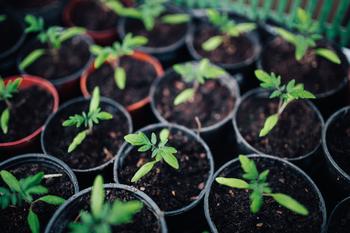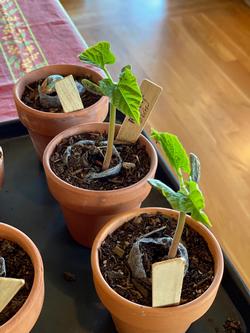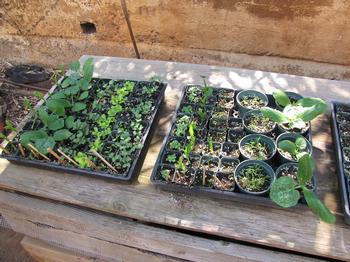Brrr – It’s cold out there!
-
Jane Scurich
-
So – you followed all the advice for starting your spring vegetable garden seeds. You researched the last frost date in your area and started the seeds 5 – 7 weeks prior to that date. You planted the seeds the proper depth in sterilized containers using a fine textured soil. The seeds germinated and produced leaves while basking in a sunny south facing window or perhaps a warm greenhouse. They’re looking super healthy and have at least three or four true leaves. It’s time for the great outdoors – right??? Not so fast!
 Tomato starts are all ready for hardening before being planted in the garden. Photo: Pixels.com
Tomato starts are all ready for hardening before being planted in the garden. Photo: Pixels.comThose super healthy little darlings you’ve been coddling for weeks still need some special care to adjust from your warm kitchen window to the vacillating weather in the garden. Cool air, chilly soil, wind, direct sun, all can be very unwelcoming to your delicate starts.
Now is the time for “hardening” or acclimating plants to the rigors of the outdoors with generally lower temperatures and humidity. This acclimating allows the starts’ cell walls and leaf cuticles to thicken so that they lose less water when exposed to the elements. This process will help to develop a stronger plant, better able to survive transplanting into garden or container soil.
The process is simple but will require a bit of your time. Approximately 7 – 14 days before you plan to transplant your seedlings, select a day with temperature above 45 degrees. Move your seedlings outdoors to an area protected from wind and direct sun for one hour on the first day. This may be under the shade of a tree or in a cold frame. If the temperature takes a sudden drop or high winds sweep in, quickly move the seedlings back to their safe, warm surroundings. Heirloom 'Prospect' bean starts germinated indoors to get a head start on the growing season. Photo: Jill Fugaro
Heirloom 'Prospect' bean starts germinated indoors to get a head start on the growing season. Photo: Jill FugaroAfter two or three days in very protected areas, gradually increase the length of time and exposure to sunnier locations. If day and night temperatures remain above 50 degrees, they can safely remain outdoors overnight.
Remember to keep the plants hydrated and protect them from snails, slugs, and animals that may be very tempted by the young growth. Apply an organic plant-safe iron phosphate snail and slug killer or hand pick the slimy critters to safeguard your precious starts.
Once acclimated to the local weather conditions, choose a cool day or early evening to transplant so that the plants will have time to adjust before being exposed to afternoon sun. Be cautious not to disturb the delicate roots when removing the starts from their container. Gently water the transplants, being careful not to wet their leaves. Once again, protect your plants from snails, slugs, and animals. Continue to monitor your transplants daily until they are well established and plan to protect them with shade cloth – or an umbrella - if the days are suddenly hot or a frost is predicted.
Nursery starts are generally expected to be hardened when you purchase them. It’s still a good idea to acclimate the starts to your location. Allow the seedlings a few days in your micro-climate before you remove them from their cozy container and place them in the garden. A variety of vegetable starts are ready for hardening before they are transplanted to the garden. Photo: Forest and Kim Starr, Wikimedia Commons
A variety of vegetable starts are ready for hardening before they are transplanted to the garden. Photo: Forest and Kim Starr, Wikimedia CommonsChilly soil can be a very unwelcoming environment and cause your seedlings to languish and stunt their growth. While we are all anxious to fill our gardens with fresh veggies, give your soil time to warm up to provide a welcoming environment for your starts.
For more information on planting time for specific vegetables, visit the UC Marin Master Gardener website at marinmg.org, click on the “Edibles” link to find an entire section devoted to growing edibles. Take some time to poke around this newly redesigned section for some great growing tips!



